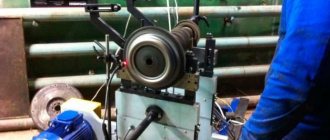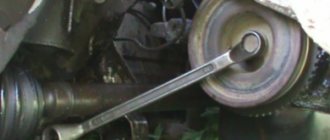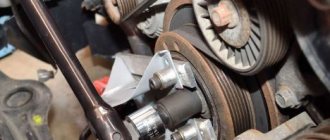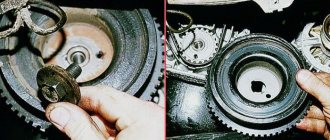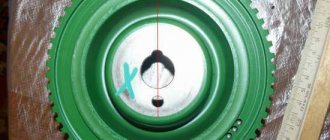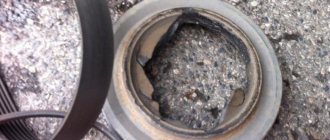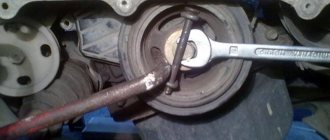There are quite a few parts in the car that, even when disassembled, may not be easy to notice. One of these parts is the crankshaft pulley - a small disc-shaped product that performs a very important task. Namely, torque transmission. In this article we will look at this problem “under a microscope” and also determine how to determine a faulty crankshaft pulley. We will also answer questions about the need to replace it and present a methodology for selecting spare parts. Let us note in advance that a pulley that does not attract attention quite rarely fails, however, in the event of a breakdown, the problem cannot be ignored - the performance of several car systems decreases.
Important Features
The operation of individual automobile units is provided by energy that is transmitted from the rotating crankshaft. For example, the rotation of the wheels is ensured by a complex system of gears and shafts, but the pump, air conditioner, timing belt and generator rotate from the crankshaft pulley. This small part is characterized by high strength and low fault tolerance. In fact, it can last as long as a car will last until it is sent for recycling.
In fact, there are many types of crankshaft pulleys for cars. At least in the sense in which the manufacturer sees it, each group of engineers has the right to resort to their own design solutions and create their own pulley options. Today there are not many varieties of this part left, but the division into types has a justification. Each pulley is adapted to certain operating conditions of the vehicle, so it is important for the driver to understand that a pair of pulleys cannot always be interchangeable. In part, this simplifies the buyer’s task, since it is enough to search for the pulley using the vehicle data or its identification number.
Why is it difficult to remove the crankshaft timing belt?
In the absence of a special tool, removing the bolt holding the crankshaft toothed pulley is very problematic, since the thread is cut so that the direction of unscrewing coincides with the torque of the shaft when the engine is running. However, this is precisely the way out of the situation. All you need is a long wrench with a 19-mm head (can be extended with a piece of pipe), which rests against the ground against the rotation of the shaft. We carry out small preparatory work - we place wedges under the front wheels, and disconnect the connector on the ignition coil. For what? To use the starter as a mechanical force applied to the bolt.
So, we have done everything to prevent the car from accidentally starting and moving away. Now we ask everyone present to move away, while we ourselves climb into the cabin (do not leave your legs sticking out) and sharply, but briefly, turn the ignition key to start. If an attempt fails, do not despair and repeat. Usually the second time, less often after the 5th or 6th attempt, the bolt turns. Now you can proceed to the next step - removing the pulley hub from the shaft, taking into account that it fits tightly and is held in place by a key. When you need to tighten the bolt back, you either need to put a lot of force into tightening it, or still find an air impact wrench by then.
Read also: Basic principles of Zen Buddhism
Purpose and device
The crankshaft pulley is a disk-shaped product. In the center there is a special hole, with the help of which the entire part can be mounted on the front part of the crankshaft. There is also a small groove intended for installing the so-called key. There are grooves on the outer part of the pulley. As the car enthusiast has probably already guessed, the grooves are made for drive belts.
In the vast majority of cases, the outer part of the pulley is a disk with a periphery, which are connected by especially durable rubber. You can notice small notches and pits on the pulley - they are needed so that the part, which is mostly a heavy metal product, is balanced . A well-balanced pulley copes with the following tasks:
- Belt cooling;
- Depreciation in cases where the nature of rotation changes;
- Transferring energy to attachments through a belt drive;
- Balancing the crankshaft as it works.
Ideally, a crankshaft pulley lasts ten years. The duration of operation is influenced by many factors, including the nature of the operation of the power unit and the condition of adjacent components. The pulley is not a serviceable part, and ideas about its repair are far from reality - the part needs to be restored and balanced, which can sometimes be as difficult as turning a new product from a solid metal blank. When making pulleys at the factory, casting and filigree turning are used, which not every craftsman can handle. So if the crankshaft pulley fails , you need to get a new one.
How to unscrew the crankshaft pulley bolt? — Encyclopedia of Japanese cars
Honda makes reliable engines, but they don’t install them like everyone else, with the belts to the right, but vice versa. Accordingly, they spin in the opposite direction - counterclockwise. The seemingly insignificant difference makes you think when you have to unscrew the crankshaft pulley bolt. This must be done at least every 100 thousand km - to replace the timing belt, but unscheduled work also happens: replacing the oil seal, for example. The bolt is tightened with a huge torque of 185 Nm for a 17 head, but to unscrew it, a much greater force is required. It will not be possible to remove the bolt while cranking the engine with the starter: the direction of rotation is wrong.
The gear engaged and the brake pedal pressed to the floor also do not help - the transmission springs, but the bolt does not give way. On older cars, there is a window in the clutch housing opposite the flywheel crown, and some people try to stop it with a mounting tool or a sharpened crowbar. Such a duel between man and machine sometimes ends in spilled blood or a torn crankcase, and sometimes both. The pulley has a hexagonal cutout for a branded key. Only you can’t find a 51 hexagon with a hole for a 17 head on sale, and ordering it for one-time work is expensive. Meanwhile, a blank for a special key is sold on any market: heating battery locknut 54, internal diameter (thread) - 39 mm, width - 10 mm. We grind down its edges by 1.5 mm, weld a strong flat handle 180-220 mm long - the tool is ready. On some pulleys, the corners between the edges of the cutout are rounded, so you can also saw off the mating parts on the nut a little. We unscrew the bolt with a 17 mm head with an extension and a powerful wrench.
You can weld the turned workpiece to a Zhiguli wrench for the crankshaft nut - you will get a VAZ-Honda universal wrench. It is convenient to rest the handle on the front wheel drive shaft.
To prevent the key from falling off, rest the extension cord on a reliable stand. Sometimes it is not even necessary to remove the wheel, but if tires with a larger diameter than the standard ones are installed, the wheel will still have to be removed or a wrench with a universal joint must be used.
Types of pulleys
As we wrote earlier, automakers can introduce various pulleys into the design of their cars. Although a part from a car of one brand may not be externally different from a part from another, there is always a difference. And the point here is not only in form, but also in balancing . However, pulleys are divided into several types. Namely:
- Under the V-belt. It is pulleys for such a belt that are installed on the vast majority of cars, trucks, and sports cars. The belt pulley is the same one-piece or all-welded part mentioned above. A key on the crankshaft prevents the pulley from turning, and the part itself is secured with a nut (in rare cases, a bolt);
- Toothed pulley. Modern timing belts do not always use a chain drive. In order to facilitate the entire system, the designers decided to use special belts. The toothed pulley has teeth on its outer rim that engage grooves on the inner surface of the belt. Despite the apparent vulnerability of the teeth, they hardly wear out;
- Damper pulley. Toothed pulleys made it possible to solve the problem of mismatched rotation angles, and damper pulleys make it possible to solve the problem of impulse mechanical influences that inevitably arise in the gas distribution system of a car. Such a pulley has a rubber layer that separates the working disk and the inner race - the damper.
All three pulleys have their advantages and disadvantages. It is important to understand that the design of the pulley also depends on how the elements adjacent to them are arranged and what are the features of their operation. The same damper pulleys made it possible to solve the problems of mechanical impacts and vibrations that occur when starting the engine and changing the frequency at which the crankshaft rotates. At the same time, the pulley damper fails quite quickly. Let's pay a little more attention to this.
Where is the crankshaft pulley located?
Basically, when lifting the hood lid, it is quite difficult to notice this design. The fact is that the pulley is located behind the generator and is therefore not noticeable. However, if you look down into the place of the belt, you can see a disk fixed to the shaft by a hub - this will be the part you are looking for. In order to remove the pulley, the driver will need to perform the following manipulations:
- Loosen the locking bolt on the generator;
- Loosen the tension bolt and lower the belt slightly;
- Disconnect the antifreeze reservoir;
- Remove the power steering belt;
- Using a wrench, unscrew the fastening element securing the pulley.
- Difficulty removing the toothed pulley
Removing the bolt holding the gear-type crankshaft pulley will be quite problematic without a special tool. Since its thread is cut in such a way that the direction of unscrewing completely coincides with the torque of the shaft, this is difficult to do. For these purposes, a wrench of size 19 is usually used, with which you will need to unscrew the part of interest against the rotation of the shaft. However, even if you managed to dismantle the crankshaft pulley, you cannot say that at this stage all work is considered completed. The fact is that the hub usually sits quite tightly on the shaft, and a special key protects it from accidental slipping. To dismantle it, you can use a special puller or aerosol lubricant. Under their action, the crankshaft pulley hub will spontaneously swing with thrust towards itself.
You can learn how to unscrew the nut on the crankshaft pulley from this video: Published: April 15, 2021
Damper or solid pulleys?
In practice, it has been proven that it is quite simple to neutralize engine vibrations using a torsional vibration damper . Such dampers are widely used in diesel cars, while they are not so common in gasoline cars (usually in trucks and buses). On passenger cars, the crankshaft pulley is usually all-metal, which is its Achilles heel - vibrations freely transmitted from the engine lead to rapid wear of the pulley, as a result of which it does not reach the 10 years of operation guaranteed by the manufacturer. The advantages of the damper pulley are:
- Engine noise is reduced;
- The amplitude of torsional vibrations is reduced by 2-5 times - this increases the survivability of the pulley and adjacent units (only the damper wears out quickly);
- Shock loads are effectively absorbed;
- Increases fuel efficiency and environmental friendliness of the vehicle.
Spare parts for Renault 10
Towing cables
1.3
Spare parts for Renault 10
Steering rack/mechanism oil seal (see standard sizes) 1.1
Contrary to the assurances of some car enthusiasts, the damper cannot seriously reduce the load on the belt. However, a pulley with a damping insert has several more significant disadvantages:
- It is more expensive than an all-metal pulley;
- The damper becomes unusable over time (the rubber insert cracks or breaks).
Despite the disadvantages, damper pulleys perform better than non-damper pulleys. One of their problems is the need for preventative replacement . As soon as the rubber element cracks, the entire pulley ceases to perform its main tasks. Please note: Modern fuel efficient engines are built to fit damper pulleys only.
And let’s immediately touch on another question: what is a lightweight pulley? This is the name given to a part made of aluminum alloy. Usually it has a damping element, but exceptions sometimes occur. For example, in the USA, the alloys from which some automobile engine parts are made are called alloys for aviation applications. They are durable, resistant to temperature changes and very lightweight. Aluminum pulleys introduce peculiarities into the operation of the engine (it slows down faster after the driver releases the gas pedal) and copes worse with vibrations (solved by installing a damper).
How to choose
When choosing a toothed pulley, you should pay attention to the processing class, the distance between the teeth and the manufacturing shape. The tooth surfaces and the belt are subject to constant loads, so high demands are placed on the quality of cutting and processing. Cutting teeth is carried out in several stages on a milling machine or devices designed specifically for the manufacture of these parts. Cast iron products are somewhat different from other varieties; they are cast in forms that completely replicate finished pulleys for timing belts and are processed using a milling machine.
The flanges on the pulley can be either absent or located on one or both sides. They are fixed in three ways:
Classification of pulleys with a damping element
If you compare the silent block and the mentioned part, you can find many similarities: the same “pie” of metal parts and the elastic element that separates them, the same layout that takes into account the perception and damping of vibrations with minimal harm to the part. Pulleys with dampers are also divided into several types. Each subsequent type is much more complex than the previous one and often much more expensive:
- Single pulley damper. These are 2 metal plates made of aluminum or steel and 1 rubber element connecting them. Most diesel and gasoline cars have just such pulleys;
- ICE pulley for stop-start system. By using a damper of a more complex design, the pulley can withstand a significant number of internal combustion engine starts without breakdown;
- Double pulley damper. Often installed on high-performance diesel vehicles. It consists of 7-8 parts made of metal and 2 parts made of rubber.
The quality of the damping element is a key factor in choosing a pulley. The fact is that it is slightly deformed exactly as many times as the mixture is ignited in the internal combustion engine cylinders. Simply put, during the course of a thousand-kilometer distance, the damper can be deformed ten million times (almost always less, but the count still goes into the millions). The condition of the damper after such a rigorous test will determine whether the pulley needs to be replaced.
Pulley removal
Unscrewing a fastening bolt or nut is only half the battle. Next you need to pull the pulley out of the shaft. The pulley cannot be removed easily by hand unless its seat is broken. In addition, if the pulley fits tightly onto the shaft, it is also secured against turning by a key.
There are special pullers for removing the pulley from the shaft. There are mechanical and hydraulic pullers.
The design of a mechanical puller is simple. Usually it has three legs, with which you need to hook the pulley itself, and rest the central rod against the shaft. After which, you need to rotate the rod, the legs will straighten and pull the pulley towards you.
There are even simpler pullers that you can make yourself.
If there is no removable device for the pulley, then you can use pry bars. If one person is filming, then take turns, moving it a little on each side so that there is no distortion. If there are two, then at the same time, from different sides, the pulley is pressed out from the crankshaft with a sharp movement.
It also happens that when using a puller, the walls of the pulley grooves cannot withstand and break off. Therefore, when using pry bars, they must be engaged as close to the shaft as possible.
Crankshaft damper pulley malfunctions
Only an external inspection will help determine with accuracy whether the pulley is suitable or needs to be replaced. However, before approaching the crankshaft, you should still pay attention to some things that indicate a faulty pulley. Namely:
- The appearance of vibrations in the cabin;
- The appearance of a knock, the frequency of which changes as the engine speed increases or decreases;
- Drive belt whistle;
- Stopping the motor.
Here's what you can see during an external examination:
- Deformation and melting of rubber (usually due to oil leaks);
- Cracks in the rubber, hub, and also in the spinning areas;
- Damper separation;
- Cracks on the belt.
Regarding the last point: normally, the belt becomes covered with cracks only after the expiration of the service life declared by the manufacturer. If cracks appear prematurely , we can talk about a pulley failure. Checking the damper is quite easy:
- Get close to the damper and draw a line with a marker from the edge to its center;
- After starting the engine, also turn on the air conditioning;
- Muffle the engine and inspect the pulley again. If the line is straight, then everything is fine with him. But if you notice two mismatched marks, then the rubber pulley inserts no longer fulfill their role.
There are many reasons why the damper pulley fails. To prevent early failure, make sure the part does not come into contact with alkali, oil or acid. Check adjacent parts, in particular, pay attention to units powered by the crankshaft. Entrust the installation of the pulley to trusted specialists or do it yourself - for the work you only need a dismantling kit (usually each pulley manufacturer produces its own kit), a wrench and a hammer.
Dismantling
In order to remove the old toothed pulley, it is necessary to remove the cover that hides the wires of the units, thus providing free access to the motor parts that require replacement. Next, the tension of the drive chain is released. After which the tank with antifreeze liquid and the electric generator are removed. If the car is equipped with power steering, it is necessary to remove the belt for this system.
Next, all that remains is to remove the mounting bolt that secures the toothed pulley to the crankshaft, but difficulties may arise here due to the direction of the thread. While the engine is moving, the bolt is constantly tightened, so at this stage of the work a pneumatic impact wrench may be required if the manual effort is not enough.
In the absence of special tools that significantly simplify the task, it is recommended to secure a wrench to the bolt to prevent it from turning. During work, the vehicle must be on jacks or with the drive wheels removed. This is necessary to ensure that the transport does not move from its place. The bolt will be unscrewed by sharply turning the ignition key, while the starter will make several turns and all that remains is to remove the bolt. After replacing the pulley, all parts are installed in the reverse order.
Making the right choice
Selecting a crankshaft pulley without a damper or with a rubber element is quite simple. But remember: a mistake in choosing will mean that the part either cannot be installed, or it will work with noise and will accelerate the wear of the car elements adjacent to it. Here's how to look for a pulley:
- By VIN code . This is a very accurate method, using which you can easily find original spare parts and even the closest analogues;
- By pulley code . Since car enthusiasts do not know exactly the codes of the spare parts they are looking for, they have to turn to electronic catalogues, social networks and thematic forums where they can be found. We recommend electronic catalogs that specify the compatibility of spare parts with specific car models - this is exactly the catalog Avto.pro has;
- According to the car . We are talking about the make, model of the car, engine data, body and year of manufacture. This method is usually used by car enthusiasts who start their search in online stores.
Searching by pulley parameters does not always give reliable results. Car enthusiasts need to clarify the applicability of the parts found. It is enough to take an existing pulley, determine its geometric parameters and compare it with the proposed ones. If everything matches, we advise you to check compatibility again by going through the catalogs and looking at the spare parts codes.
When choosing a pulley, also keep in mind the mounting bolts used. The fact is that the bolt is screwed in with a fairly high tightening torque, as a result of which it approaches its deformation limit. Simply put, a reused bolt is longer than a new one. As a rule, pulleys are sold complete with special washers and bolts.
Dismantling and replacement
Regardless of the design, where the part is located, it is important to remove and install it in the same order. Depending on the location of the motor, the part is located in the front part behind the cooling radiator. But if the motor is placed across the engine compartment, then your hand will not reach the part. Because to remove the crankshaft pulley, you need to remove the right wheel. If it is difficult to change, it makes sense to pay attention to the drawing, the work will speed up.
The vehicle is rolled onto the inspection hole and secured so that the car does not move from its place. To get there and remove the structure, you need to unscrew all the parts that impede access (air filter, mud flaps, etc.). Remove the generator belt. Next, open the clutch block plug and insert a pry bar into the hole to lock the flywheel.
The elements of the part are characterized by strong fixation, so they are not easy to remove. To turn a part, it is necessary to make a lot of effort. If dismantling is performed for the first time, it will be difficult to unscrew the crankshaft pulley. The reason is that factory production is characterized by strong tightening of the component parts.
Important! The right screw pattern means that the unscrewing process occurs counterclockwise. The car part spins in the other direction, so if it has oxidized, it is not so easy to disassemble it; it is useful to use additional means.
How to unscrew the crankshaft pulley nut
When turning fasteners, it is important to follow the recommendations, then the process will take at least 15 minutes. The effort should be applied as close to the camshaft as possible:
- use a pry bar to pry it up from all sides;
- If necessary, use a special universal crankshaft pulley puller for this part.
The device is presented in the form of a hairpin with 2-3 grips. The end of the gripper is secured to the edges of the part, and the end of the pin is placed in the middle of the shaft.
Scroll clockwise. But not all brands of cars turn clockwise; in some cars, the work must be done in the opposite direction. In this case, it is important to put your gear lever in 4th speed and turn on the handbrake.
If you can’t turn it, the lever should be in the neutral position. The next step is to remove the candlesticks. The key is placed on the floor or on the rear side member and turned in the direction of movement of the device.
All maneuvers make it easier to scroll, so further actions must be performed manually; if necessary, lubricate with brake fluid or WD grease. In addition, tapping the edges of the head can make your work easier.
How to remove the crankshaft pulley bolt
To do the job efficiently, the disassembled machine is placed on a stump. The pin holds the part together and is usually found in front-wheel drive automatic cars. The thread is designed in such a way that it is tightened during the torque when moving.
It is necessary to perform actions that open access to the base. To do this, it is important to stop the rotation well. A mount is used as a fixation. The tool is inserted into the flywheel gears. It must be adjusted securely so that it does not fall out during the turning process. Therefore, it is better to do the work with an assistant. Next, put a socket head of the same diameter as the pin onto the pin, attach a lever and an extension (a piece of durable pipe). After this they begin to slowly unscrew it.
Important! The longer the extension, the easier it is to unwind.
People's automobile experience
The difficulty of dismantling lies in the specially selected strong connection, without play. The fasteners are tightly screwed. They practice using a pry bar, while slowly pressing on the back surface of the part.
We recommend: How to replace and remove the fuel pump on a Lada Kalina with your own hands?
When purchasing a part, you must have new fasteners. You will need a front oil seal and suspension belts. When purchasing, you need to pay attention to the grooves and marks. They must be free of defects. Otherwise, after a while you need to replace everything with a new one.
Important! When performing work, you need to pay attention to the crankcase ventilation system. If contaminated, under the influence of excess pressure, the oil seal will leak lubricant. When screwing, you need patience and, as a rule, you can achieve results after 3-4 attempts.
Installing the pulley on the crankshaft
To properly install the crankshaft pulley, it is necessary to lubricate it with grease or other viscous agent. This will make the fastener installation process easier. To put it on, tilt the washer slightly to the side and pull it onto the base. Next, you can use a tapping motion with a hammer to process the hub through a soft rubber gasket. Then, in the reverse order, you need to tighten the other parts of the car.
Important! If you do not fit it tightly into the groove, then everything will hang out, so you will need to replace it with a new one soon.
Brand tour
There are many manufacturers of automotive crankshaft pulleys. It is important for a car enthusiast to determine the best manufacturer - only his product will last a long time. We focus on such a seemingly trivial issue because many car enthusiasts buy cheap analogues of dubious quality . Good analogues are offered by the following companies:
- SNR (France);
- Corteco (Germany);
- SKF (Sweden);
- NTN (Japan).
Typically, pulleys from these companies are included in the original package. The cost of the part is quite high, but it is more than justified. Budget analogues can be offered by the following companies:
- SWAG (Germany);
- Magneti Marelli (Italy);
- Febi (Germany);
- SAT (China);
- Contitech (Germany).
If a car enthusiast decides to give preference to a budget option , then he should be aware of the risks. Periodic inspection of the pulley will become mandatory. Good analogues can be found at Contitech, Magnetti Marelli, but you may not be so lucky with Febi. The red price for the pulley is the one set by the sellers for the product from Febi - we absolutely do not recommend taking anything cheaper.
Pulley malfunctions and checking their condition
The pulley and belt drives operate by friction between the contact surfaces, so a common reason for replacing a pulley is wear out of the working plane. Due to dynamic loads, the metal of the pulleys cracks and chips.
Another typical problem for such parts is key play in the crankshaft keyway. The reason for this is wear on the landing planes of the pulley with the shaft. The pulley fastener with such a malfunction gradually unscrews due to vibrations, increasing the play more and more.
Prolonged operation of the crankshaft with a “loose” pulley will lead to wear and tear of the keyway itself and unscrewing of the crankshaft pulley. Next, the entire assembly rotates on the seat, destroying the key joint, the pulley housing and the crankshaft itself. If a crankshaft pulley is torn off on your engine, there is a high probability that the entire crankshaft will need to be replaced.
Severely damaged crankshaft pulley
In order to determine the condition of the crankshaft pulley, you must:
- remove the pulley belts, inspect its edges and body for damage, cracks, wear;
- shake the pulley; if there is critical play, the assembly must be disassembled and inspected for wear and damage;
- Usually, repair instructions contain the dimensions of permissible wear of parts, distances to the nearest engine components. Checking these dimensions will help determine the suitability of the pulleys for further use.
Conclusion
The crankshaft pulley is definitely not a part you should skimp on. Purchasing analogues from suppliers for the conveyor is acceptable. It is easy to select this part, guided by the car data or catalog number. Beware of fakes! They are easily betrayed by poor quality packaging, poor quality of work with metal and rubber, as well as inconsistency of codes and concealment of important information from the buyer. Usually the country of manufacture of the counterfeit is not indicated. And remember: there are no eternal dampers. If the description of a damper pulley states that the damper itself is eternal, then the pulley simply may not have one - this is a rare, but still common, scheme to deceive buyers online.
Torsional vibration damper history
During engine operation, the crankshaft is subjected to very heavy torsional loads. This fact was encountered literally immediately as soon as internal combustion engines acquired high torques. At first this concerned ship engines, and then land and aircraft designers “learned” about it. There were no issues with the single-cylinder engine. A short crankshaft solved all the problems. But with the increase in cylinders and piston strokes, this became a problem. That is, the crankshaft began to “twist”. To make it more clear, take a ruler 15-20 centimeters long by the long edges and turn it around the axis in different directions. It will bend quite strongly. This is, of course, a slightly exaggerated picture, but the crankshaft in in-line multi-cylinder engines “tends to bend” in approximately the same way. In automobile engines, BMW was the first to encounter this problem, then Nissan. Moreover, as usual, the methods of struggle diverged; some began to increase the diameters of the crankshafts, while others began to fight vibration damping.
pulley and damper assembly
Possible faults
Removal and, if necessary, replacement of the pulley may be required in the following cases:
- If the hub has turned. It must be said that most often this happens due to previous inept repairs. The fact is that the VAZ 2110 has a fixing sleeve in the seat for the damper, pressed into the gear. It tends to fall out of the gear, causing the hub to rotate;
- Oil leaked from under the front crankshaft oil seal;
- The lightweight crankshaft began to resonate strongly;
- The old-style pulley or damper is loose;
- The damper seat broke. In case of such a breakdown, a replacement is needed, preferably together with the crankshaft gear;
- If it is necessary to remove the crankshaft - for repairs, replacement of liners, half rings, converting it into a lightweight one, etc.
Removing the damper
On a VAZ 2110, the damper is removed in the following sequence:
- Disconnect the ground from the battery;
- Remove the radiator fan and fluid coupling;
- After loosening the bolts securing the fan pulley, remove the belt;
- It is advisable to remove the radiator, but if it does not interfere, you can leave it, protecting it from damage from the engine compartment with a sheet of plywood or cardboard;
- Remove the pulley from the radiator fan;
- We gain access to the damper, unscrew the bolts, dismantle it;
- When removing the hub, you need to secure it from turning (for which there is a special tool).
Next we proceed depending on the purpose of the analysis. If you only need to replace the damper, we do it and assemble everything in the reverse order.
You should know that replacing the liners on a VAZ 2110 can be done either with or without removing the crankshaft. But this requires a special device, and besides, it is better to entrust such work to an experienced mechanic - a mechanic.
If the crankshaft was dismantled to replace the liners or half rings, then we continue:
- Remove the lightweight or regular crankshaft;
- We remove the half rings;
- We evaluate the condition of the liners, and if they do not need replacement yet, then be sure to remove them and mark each of them;
- But, unfortunately, no matter how carefully the owner treats his VAZ 2110, sooner or later the time for physical wear comes for the liners - they need replacement.
- Four repair kits of inserts are produced for the VAZ 2110. You need to buy them only as a set, and only in a strict sequence of sizes. Sometimes, however, situations are possible when you have to purchase them “through size”;
- thus, the crankshaft only lasts for four (and sometimes even three) overhauls;
- replacement of liners cannot occur without grinding the crankshaft. The only exception is if it is replaced with a new one. At the same time, an experienced craftsman can turn the crankshaft into a lightweight one.
But if replacing the crankshaft pulley is not such a difficult task, and almost any home craftsman can do it, then grinding and tuning the crankshaft should be entrusted only to experienced motorists.
When reassembling, please note that the groove on the hub must be aligned with the segment key. In addition, the bolt holding the hub requires a torque wrench. Its tightening torque should be 400 N/m.
Dismantling the “single” pulley (old model)
Actually, removing and reassembling the old-style pulley does not have any special differences, except that it is easier to remove. It is enough to unscrew just one central bolt and pry off the pulley with two screwdrivers.
If you find an error, please select a piece of text and press Ctrl+Enter.
Source
Purpose, design and replacement of the VAZ 2110 crankshaft pulley
VAZ engines have two, slightly different modifications of the torsional vibration damper and crankshaft hubs, in other words, the pulley. On a VAZ 2110, the crankshaft pulley can be made as a block, or also have a separate system with a hub - a damper.
When the production of the “ten” had just begun, the crankshaft vibration damper was a single unit, and was secured with only one central bolt. Along with the injection VAZ 2110, a damper appeared. It is bolted to the hub.

